Workplace Bullying in the OR: Results of a Descriptive Study Report
VerifiedAdded on 2020/04/21
|13
|3396
|61
Report
AI Summary
This report presents a descriptive study on workplace bullying within operating room environments. The study explores the prevalence and impact of bullying, examining the experiences of nurses, physicians, and other medical staff. The research methodology includes a cross-sectional survey conducted in two medical centers, utilizing both primary and secondary data collection methods. The report critically discusses the definition of bullying, the sampling process, data collection techniques, and the data analysis methods employed, including the use of SPSS software and logistic regression. Key findings include the identification of negative acts, the frequency of bullying incidents, and the demographic distribution of participants. The study also investigates the relationship between workplace bullying, emotional exhaustion, and patient safety, contributing valuable insights into the challenges faced by healthcare professionals and the need for interventions to create a more supportive and respectful work environment. This report is available on Desklib, a platform offering AI-powered study tools.
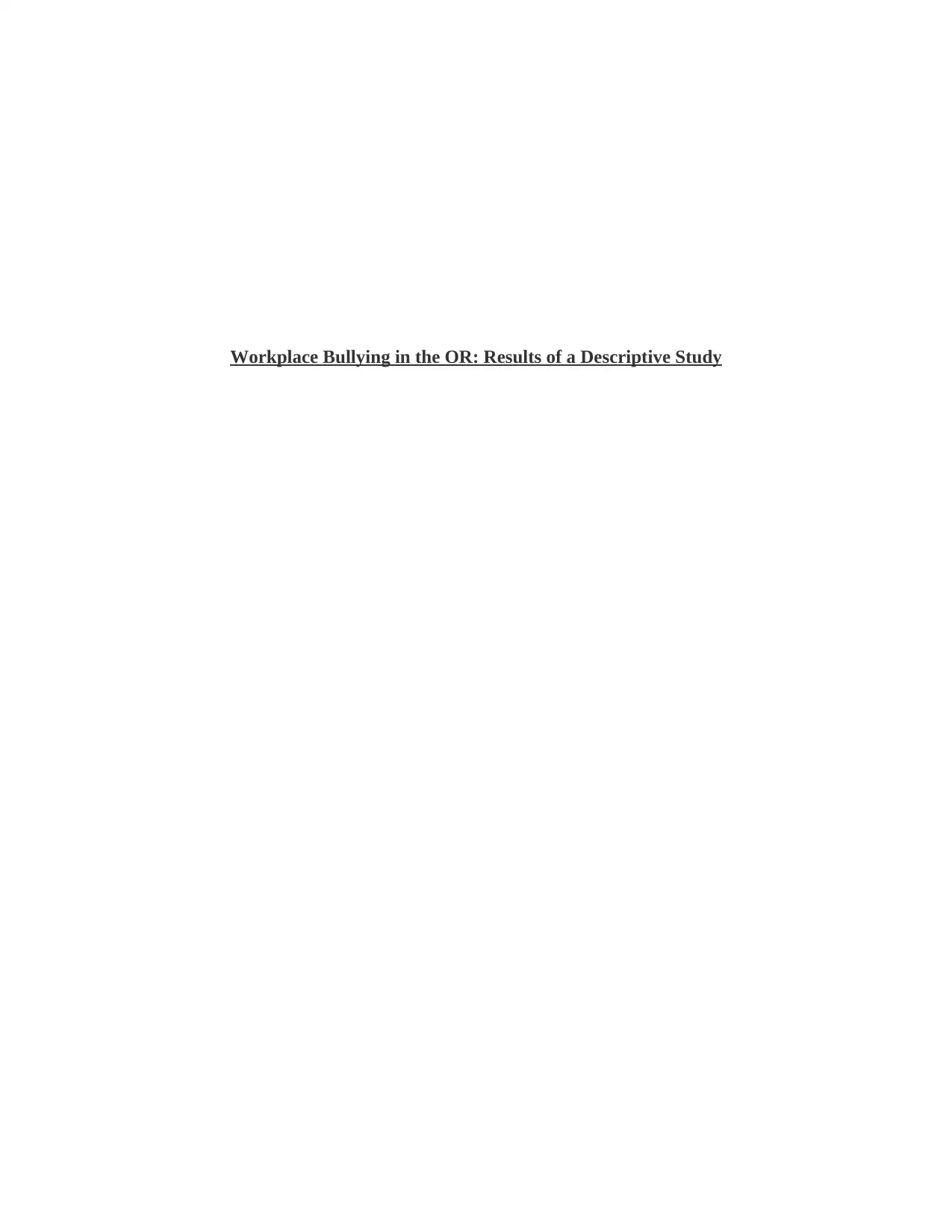
Workplace Bullying in the OR: Results of a Descriptive Study
Paraphrase This Document
Need a fresh take? Get an instant paraphrase of this document with our AI Paraphraser
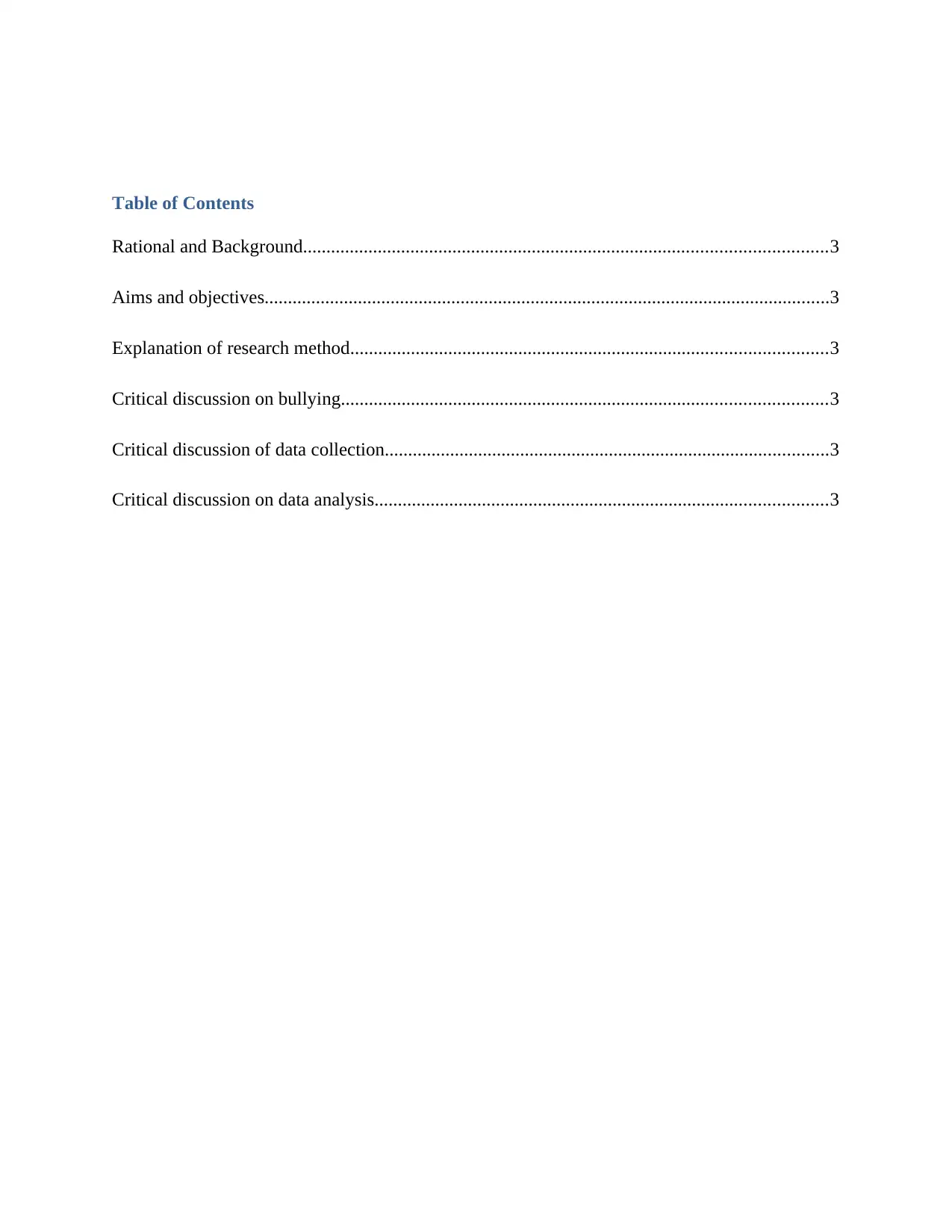
Table of Contents
Rational and Background................................................................................................................3
Aims and objectives.........................................................................................................................3
Explanation of research method......................................................................................................3
Critical discussion on bullying........................................................................................................3
Critical discussion of data collection...............................................................................................3
Critical discussion on data analysis.................................................................................................3
Rational and Background................................................................................................................3
Aims and objectives.........................................................................................................................3
Explanation of research method......................................................................................................3
Critical discussion on bullying........................................................................................................3
Critical discussion of data collection...............................................................................................3
Critical discussion on data analysis.................................................................................................3
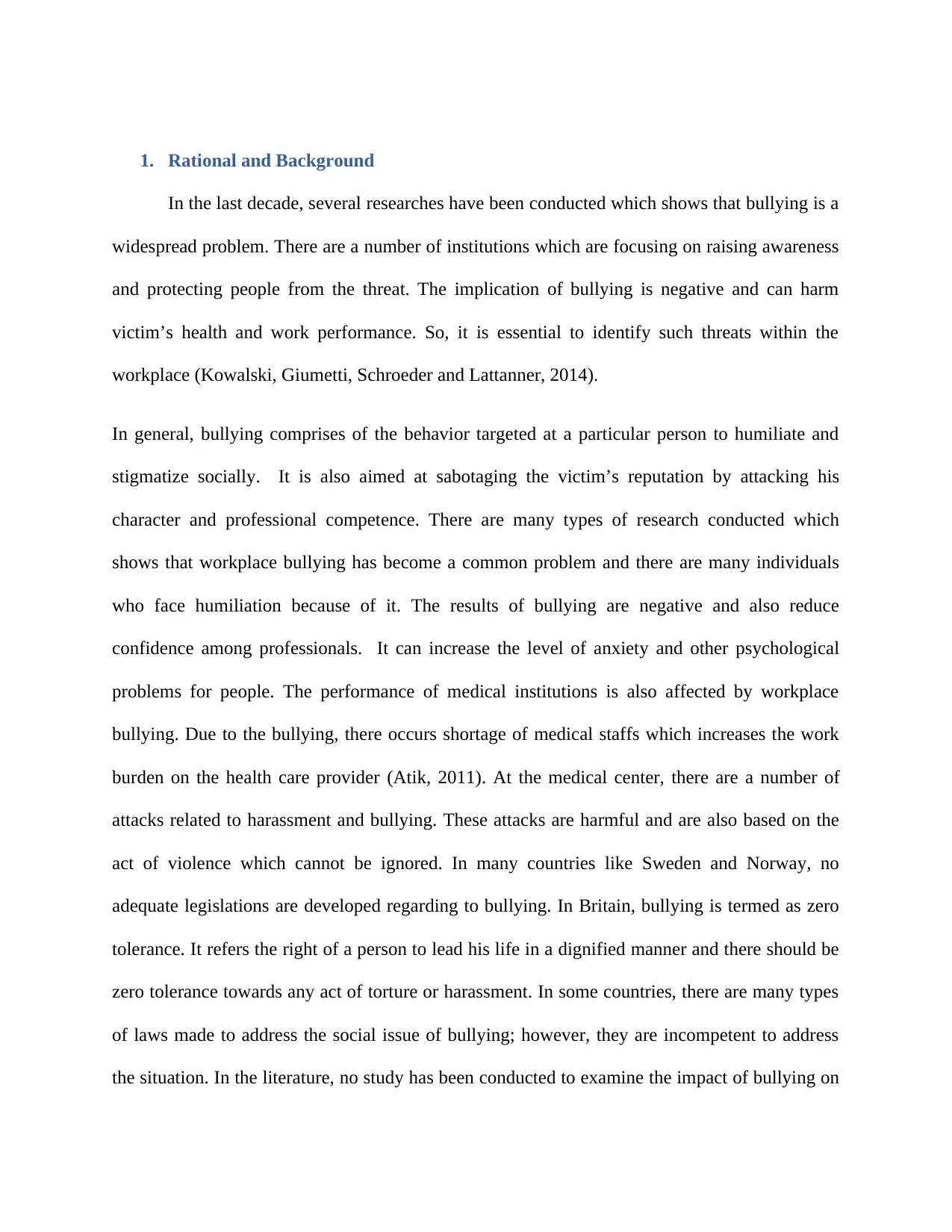
1. Rational and Background
In the last decade, several researches have been conducted which shows that bullying is a
widespread problem. There are a number of institutions which are focusing on raising awareness
and protecting people from the threat. The implication of bullying is negative and can harm
victim’s health and work performance. So, it is essential to identify such threats within the
workplace (Kowalski, Giumetti, Schroeder and Lattanner, 2014).
In general, bullying comprises of the behavior targeted at a particular person to humiliate and
stigmatize socially. It is also aimed at sabotaging the victim’s reputation by attacking his
character and professional competence. There are many types of research conducted which
shows that workplace bullying has become a common problem and there are many individuals
who face humiliation because of it. The results of bullying are negative and also reduce
confidence among professionals. It can increase the level of anxiety and other psychological
problems for people. The performance of medical institutions is also affected by workplace
bullying. Due to the bullying, there occurs shortage of medical staffs which increases the work
burden on the health care provider (Atik, 2011). At the medical center, there are a number of
attacks related to harassment and bullying. These attacks are harmful and are also based on the
act of violence which cannot be ignored. In many countries like Sweden and Norway, no
adequate legislations are developed regarding to bullying. In Britain, bullying is termed as zero
tolerance. It refers the right of a person to lead his life in a dignified manner and there should be
zero tolerance towards any act of torture or harassment. In some countries, there are many types
of laws made to address the social issue of bullying; however, they are incompetent to address
the situation. In the literature, no study has been conducted to examine the impact of bullying on
In the last decade, several researches have been conducted which shows that bullying is a
widespread problem. There are a number of institutions which are focusing on raising awareness
and protecting people from the threat. The implication of bullying is negative and can harm
victim’s health and work performance. So, it is essential to identify such threats within the
workplace (Kowalski, Giumetti, Schroeder and Lattanner, 2014).
In general, bullying comprises of the behavior targeted at a particular person to humiliate and
stigmatize socially. It is also aimed at sabotaging the victim’s reputation by attacking his
character and professional competence. There are many types of research conducted which
shows that workplace bullying has become a common problem and there are many individuals
who face humiliation because of it. The results of bullying are negative and also reduce
confidence among professionals. It can increase the level of anxiety and other psychological
problems for people. The performance of medical institutions is also affected by workplace
bullying. Due to the bullying, there occurs shortage of medical staffs which increases the work
burden on the health care provider (Atik, 2011). At the medical center, there are a number of
attacks related to harassment and bullying. These attacks are harmful and are also based on the
act of violence which cannot be ignored. In many countries like Sweden and Norway, no
adequate legislations are developed regarding to bullying. In Britain, bullying is termed as zero
tolerance. It refers the right of a person to lead his life in a dignified manner and there should be
zero tolerance towards any act of torture or harassment. In some countries, there are many types
of laws made to address the social issue of bullying; however, they are incompetent to address
the situation. In the literature, no study has been conducted to examine the impact of bullying on
⊘ This is a preview!⊘
Do you want full access?
Subscribe today to unlock all pages.

Trusted by 1+ million students worldwide
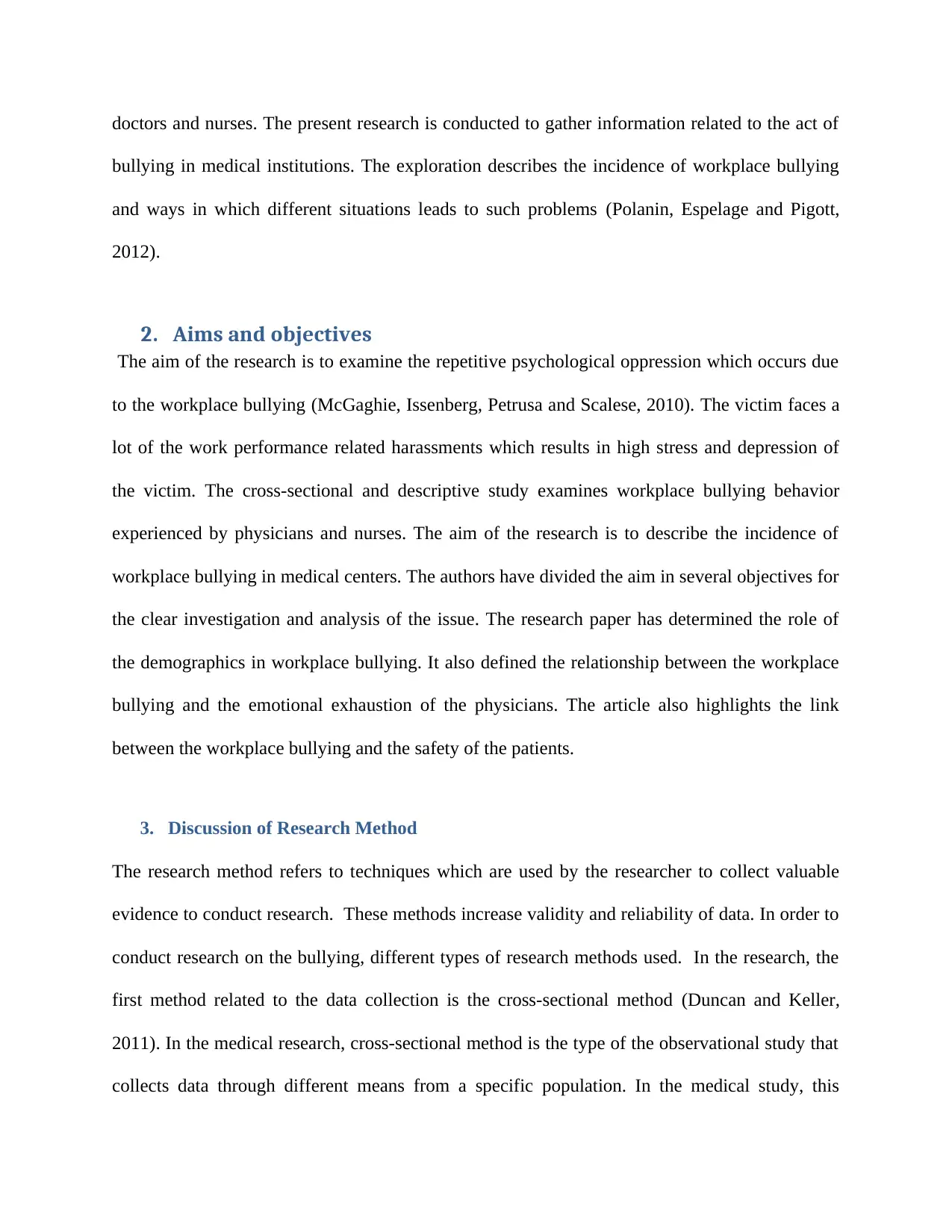
doctors and nurses. The present research is conducted to gather information related to the act of
bullying in medical institutions. The exploration describes the incidence of workplace bullying
and ways in which different situations leads to such problems (Polanin, Espelage and Pigott,
2012).
2. Aims and objectives
The aim of the research is to examine the repetitive psychological oppression which occurs due
to the workplace bullying (McGaghie, Issenberg, Petrusa and Scalese, 2010). The victim faces a
lot of the work performance related harassments which results in high stress and depression of
the victim. The cross-sectional and descriptive study examines workplace bullying behavior
experienced by physicians and nurses. The aim of the research is to describe the incidence of
workplace bullying in medical centers. The authors have divided the aim in several objectives for
the clear investigation and analysis of the issue. The research paper has determined the role of
the demographics in workplace bullying. It also defined the relationship between the workplace
bullying and the emotional exhaustion of the physicians. The article also highlights the link
between the workplace bullying and the safety of the patients.
3. Discussion of Research Method
The research method refers to techniques which are used by the researcher to collect valuable
evidence to conduct research. These methods increase validity and reliability of data. In order to
conduct research on the bullying, different types of research methods used. In the research, the
first method related to the data collection is the cross-sectional method (Duncan and Keller,
2011). In the medical research, cross-sectional method is the type of the observational study that
collects data through different means from a specific population. In the medical study, this
bullying in medical institutions. The exploration describes the incidence of workplace bullying
and ways in which different situations leads to such problems (Polanin, Espelage and Pigott,
2012).
2. Aims and objectives
The aim of the research is to examine the repetitive psychological oppression which occurs due
to the workplace bullying (McGaghie, Issenberg, Petrusa and Scalese, 2010). The victim faces a
lot of the work performance related harassments which results in high stress and depression of
the victim. The cross-sectional and descriptive study examines workplace bullying behavior
experienced by physicians and nurses. The aim of the research is to describe the incidence of
workplace bullying in medical centers. The authors have divided the aim in several objectives for
the clear investigation and analysis of the issue. The research paper has determined the role of
the demographics in workplace bullying. It also defined the relationship between the workplace
bullying and the emotional exhaustion of the physicians. The article also highlights the link
between the workplace bullying and the safety of the patients.
3. Discussion of Research Method
The research method refers to techniques which are used by the researcher to collect valuable
evidence to conduct research. These methods increase validity and reliability of data. In order to
conduct research on the bullying, different types of research methods used. In the research, the
first method related to the data collection is the cross-sectional method (Duncan and Keller,
2011). In the medical research, cross-sectional method is the type of the observational study that
collects data through different means from a specific population. In the medical study, this
Paraphrase This Document
Need a fresh take? Get an instant paraphrase of this document with our AI Paraphraser
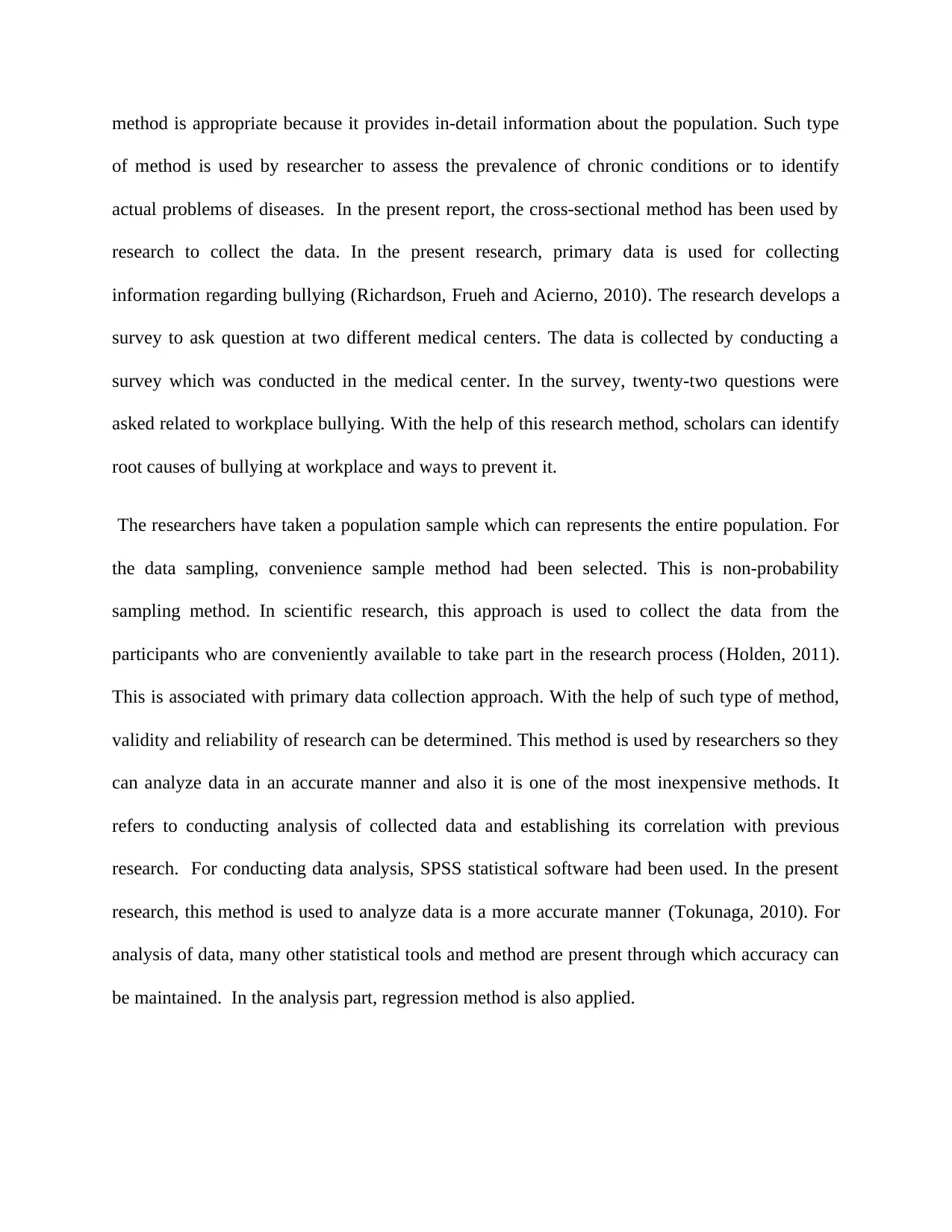
method is appropriate because it provides in-detail information about the population. Such type
of method is used by researcher to assess the prevalence of chronic conditions or to identify
actual problems of diseases. In the present report, the cross-sectional method has been used by
research to collect the data. In the present research, primary data is used for collecting
information regarding bullying (Richardson, Frueh and Acierno, 2010). The research develops a
survey to ask question at two different medical centers. The data is collected by conducting a
survey which was conducted in the medical center. In the survey, twenty-two questions were
asked related to workplace bullying. With the help of this research method, scholars can identify
root causes of bullying at workplace and ways to prevent it.
The researchers have taken a population sample which can represents the entire population. For
the data sampling, convenience sample method had been selected. This is non-probability
sampling method. In scientific research, this approach is used to collect the data from the
participants who are conveniently available to take part in the research process (Holden, 2011).
This is associated with primary data collection approach. With the help of such type of method,
validity and reliability of research can be determined. This method is used by researchers so they
can analyze data in an accurate manner and also it is one of the most inexpensive methods. It
refers to conducting analysis of collected data and establishing its correlation with previous
research. For conducting data analysis, SPSS statistical software had been used. In the present
research, this method is used to analyze data is a more accurate manner (Tokunaga, 2010). For
analysis of data, many other statistical tools and method are present through which accuracy can
be maintained. In the analysis part, regression method is also applied.
of method is used by researcher to assess the prevalence of chronic conditions or to identify
actual problems of diseases. In the present report, the cross-sectional method has been used by
research to collect the data. In the present research, primary data is used for collecting
information regarding bullying (Richardson, Frueh and Acierno, 2010). The research develops a
survey to ask question at two different medical centers. The data is collected by conducting a
survey which was conducted in the medical center. In the survey, twenty-two questions were
asked related to workplace bullying. With the help of this research method, scholars can identify
root causes of bullying at workplace and ways to prevent it.
The researchers have taken a population sample which can represents the entire population. For
the data sampling, convenience sample method had been selected. This is non-probability
sampling method. In scientific research, this approach is used to collect the data from the
participants who are conveniently available to take part in the research process (Holden, 2011).
This is associated with primary data collection approach. With the help of such type of method,
validity and reliability of research can be determined. This method is used by researchers so they
can analyze data in an accurate manner and also it is one of the most inexpensive methods. It
refers to conducting analysis of collected data and establishing its correlation with previous
research. For conducting data analysis, SPSS statistical software had been used. In the present
research, this method is used to analyze data is a more accurate manner (Tokunaga, 2010). For
analysis of data, many other statistical tools and method are present through which accuracy can
be maintained. In the analysis part, regression method is also applied.
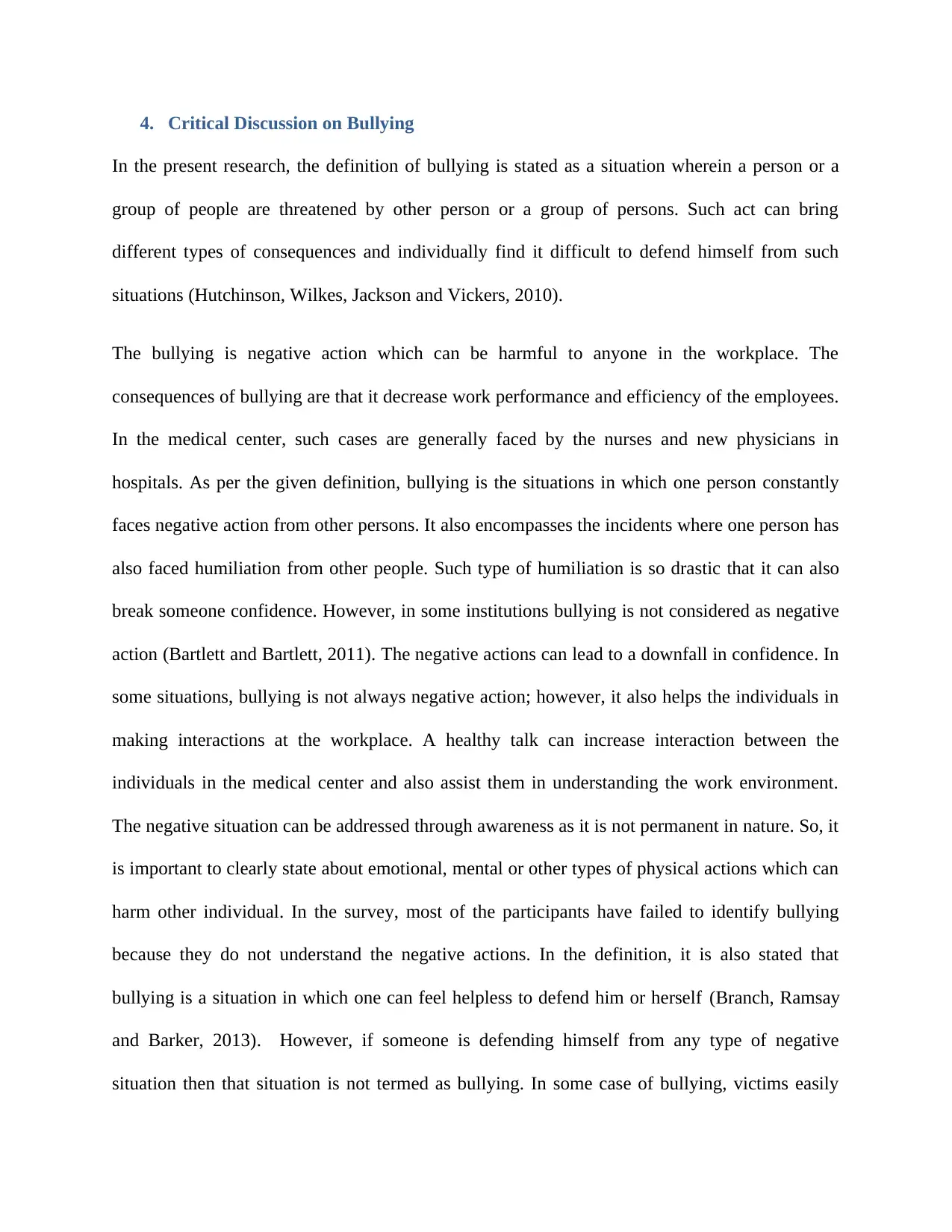
4. Critical Discussion on Bullying
In the present research, the definition of bullying is stated as a situation wherein a person or a
group of people are threatened by other person or a group of persons. Such act can bring
different types of consequences and individually find it difficult to defend himself from such
situations (Hutchinson, Wilkes, Jackson and Vickers, 2010).
The bullying is negative action which can be harmful to anyone in the workplace. The
consequences of bullying are that it decrease work performance and efficiency of the employees.
In the medical center, such cases are generally faced by the nurses and new physicians in
hospitals. As per the given definition, bullying is the situations in which one person constantly
faces negative action from other persons. It also encompasses the incidents where one person has
also faced humiliation from other people. Such type of humiliation is so drastic that it can also
break someone confidence. However, in some institutions bullying is not considered as negative
action (Bartlett and Bartlett, 2011). The negative actions can lead to a downfall in confidence. In
some situations, bullying is not always negative action; however, it also helps the individuals in
making interactions at the workplace. A healthy talk can increase interaction between the
individuals in the medical center and also assist them in understanding the work environment.
The negative situation can be addressed through awareness as it is not permanent in nature. So, it
is important to clearly state about emotional, mental or other types of physical actions which can
harm other individual. In the survey, most of the participants have failed to identify bullying
because they do not understand the negative actions. In the definition, it is also stated that
bullying is a situation in which one can feel helpless to defend him or herself (Branch, Ramsay
and Barker, 2013). However, if someone is defending himself from any type of negative
situation then that situation is not termed as bullying. In some case of bullying, victims easily
In the present research, the definition of bullying is stated as a situation wherein a person or a
group of people are threatened by other person or a group of persons. Such act can bring
different types of consequences and individually find it difficult to defend himself from such
situations (Hutchinson, Wilkes, Jackson and Vickers, 2010).
The bullying is negative action which can be harmful to anyone in the workplace. The
consequences of bullying are that it decrease work performance and efficiency of the employees.
In the medical center, such cases are generally faced by the nurses and new physicians in
hospitals. As per the given definition, bullying is the situations in which one person constantly
faces negative action from other persons. It also encompasses the incidents where one person has
also faced humiliation from other people. Such type of humiliation is so drastic that it can also
break someone confidence. However, in some institutions bullying is not considered as negative
action (Bartlett and Bartlett, 2011). The negative actions can lead to a downfall in confidence. In
some situations, bullying is not always negative action; however, it also helps the individuals in
making interactions at the workplace. A healthy talk can increase interaction between the
individuals in the medical center and also assist them in understanding the work environment.
The negative situation can be addressed through awareness as it is not permanent in nature. So, it
is important to clearly state about emotional, mental or other types of physical actions which can
harm other individual. In the survey, most of the participants have failed to identify bullying
because they do not understand the negative actions. In the definition, it is also stated that
bullying is a situation in which one can feel helpless to defend him or herself (Branch, Ramsay
and Barker, 2013). However, if someone is defending himself from any type of negative
situation then that situation is not termed as bullying. In some case of bullying, victims easily
⊘ This is a preview!⊘
Do you want full access?
Subscribe today to unlock all pages.

Trusted by 1+ million students worldwide
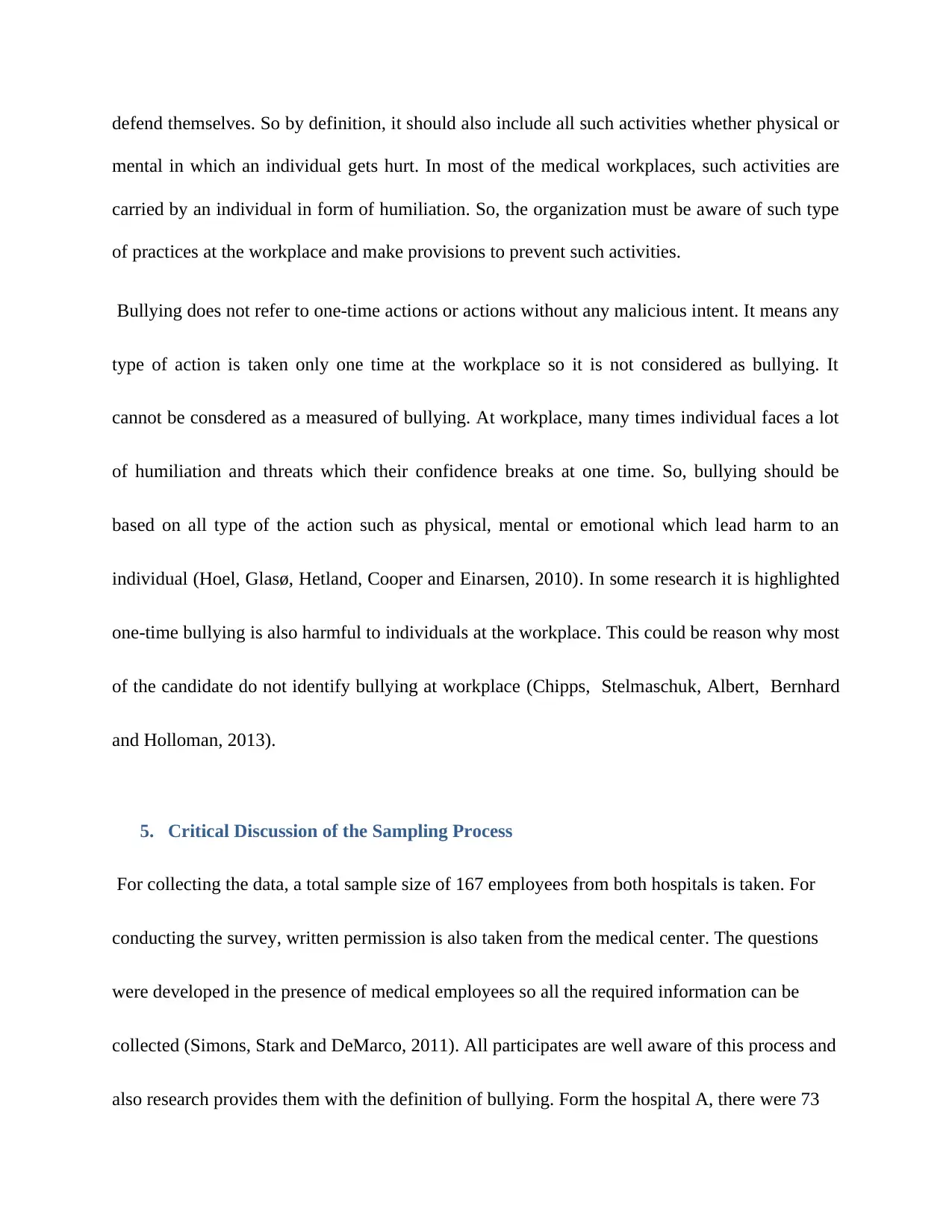
defend themselves. So by definition, it should also include all such activities whether physical or
mental in which an individual gets hurt. In most of the medical workplaces, such activities are
carried by an individual in form of humiliation. So, the organization must be aware of such type
of practices at the workplace and make provisions to prevent such activities.
Bullying does not refer to one-time actions or actions without any malicious intent. It means any
type of action is taken only one time at the workplace so it is not considered as bullying. It
cannot be consdered as a measured of bullying. At workplace, many times individual faces a lot
of humiliation and threats which their confidence breaks at one time. So, bullying should be
based on all type of the action such as physical, mental or emotional which lead harm to an
individual (Hoel, Glasø, Hetland, Cooper and Einarsen, 2010). In some research it is highlighted
one-time bullying is also harmful to individuals at the workplace. This could be reason why most
of the candidate do not identify bullying at workplace (Chipps, Stelmaschuk, Albert, Bernhard
and Holloman, 2013).
5. Critical Discussion of the Sampling Process
For collecting the data, a total sample size of 167 employees from both hospitals is taken. For
conducting the survey, written permission is also taken from the medical center. The questions
were developed in the presence of medical employees so all the required information can be
collected (Simons, Stark and DeMarco, 2011). All participates are well aware of this process and
also research provides them with the definition of bullying. Form the hospital A, there were 73
mental in which an individual gets hurt. In most of the medical workplaces, such activities are
carried by an individual in form of humiliation. So, the organization must be aware of such type
of practices at the workplace and make provisions to prevent such activities.
Bullying does not refer to one-time actions or actions without any malicious intent. It means any
type of action is taken only one time at the workplace so it is not considered as bullying. It
cannot be consdered as a measured of bullying. At workplace, many times individual faces a lot
of humiliation and threats which their confidence breaks at one time. So, bullying should be
based on all type of the action such as physical, mental or emotional which lead harm to an
individual (Hoel, Glasø, Hetland, Cooper and Einarsen, 2010). In some research it is highlighted
one-time bullying is also harmful to individuals at the workplace. This could be reason why most
of the candidate do not identify bullying at workplace (Chipps, Stelmaschuk, Albert, Bernhard
and Holloman, 2013).
5. Critical Discussion of the Sampling Process
For collecting the data, a total sample size of 167 employees from both hospitals is taken. For
conducting the survey, written permission is also taken from the medical center. The questions
were developed in the presence of medical employees so all the required information can be
collected (Simons, Stark and DeMarco, 2011). All participates are well aware of this process and
also research provides them with the definition of bullying. Form the hospital A, there were 73
Paraphrase This Document
Need a fresh take? Get an instant paraphrase of this document with our AI Paraphraser
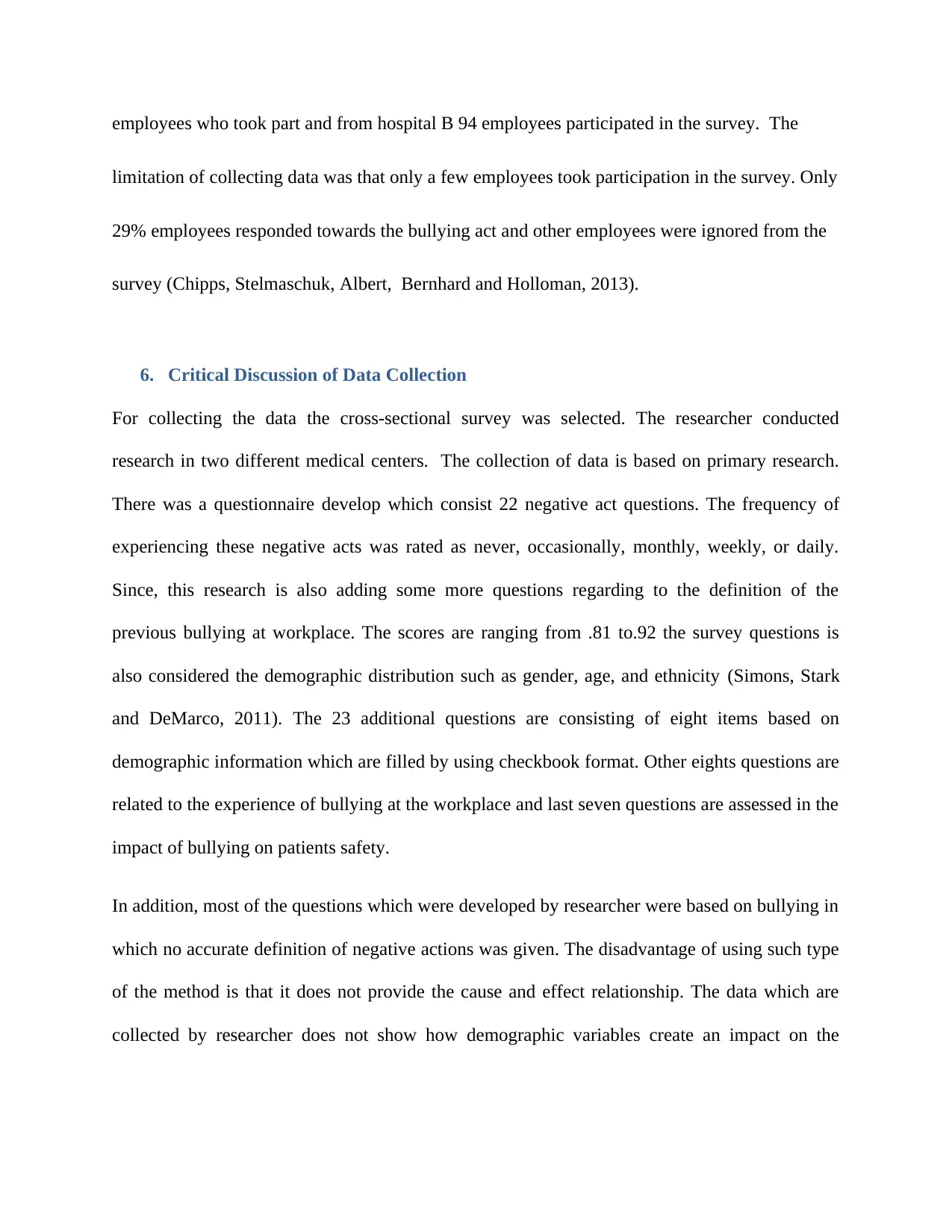
employees who took part and from hospital B 94 employees participated in the survey. The
limitation of collecting data was that only a few employees took participation in the survey. Only
29% employees responded towards the bullying act and other employees were ignored from the
survey (Chipps, Stelmaschuk, Albert, Bernhard and Holloman, 2013).
6. Critical Discussion of Data Collection
For collecting the data the cross-sectional survey was selected. The researcher conducted
research in two different medical centers. The collection of data is based on primary research.
There was a questionnaire develop which consist 22 negative act questions. The frequency of
experiencing these negative acts was rated as never, occasionally, monthly, weekly, or daily.
Since, this research is also adding some more questions regarding to the definition of the
previous bullying at workplace. The scores are ranging from .81 to.92 the survey questions is
also considered the demographic distribution such as gender, age, and ethnicity (Simons, Stark
and DeMarco, 2011). The 23 additional questions are consisting of eight items based on
demographic information which are filled by using checkbook format. Other eights questions are
related to the experience of bullying at the workplace and last seven questions are assessed in the
impact of bullying on patients safety.
In addition, most of the questions which were developed by researcher were based on bullying in
which no accurate definition of negative actions was given. The disadvantage of using such type
of the method is that it does not provide the cause and effect relationship. The data which are
collected by researcher does not show how demographic variables create an impact on the
limitation of collecting data was that only a few employees took participation in the survey. Only
29% employees responded towards the bullying act and other employees were ignored from the
survey (Chipps, Stelmaschuk, Albert, Bernhard and Holloman, 2013).
6. Critical Discussion of Data Collection
For collecting the data the cross-sectional survey was selected. The researcher conducted
research in two different medical centers. The collection of data is based on primary research.
There was a questionnaire develop which consist 22 negative act questions. The frequency of
experiencing these negative acts was rated as never, occasionally, monthly, weekly, or daily.
Since, this research is also adding some more questions regarding to the definition of the
previous bullying at workplace. The scores are ranging from .81 to.92 the survey questions is
also considered the demographic distribution such as gender, age, and ethnicity (Simons, Stark
and DeMarco, 2011). The 23 additional questions are consisting of eight items based on
demographic information which are filled by using checkbook format. Other eights questions are
related to the experience of bullying at the workplace and last seven questions are assessed in the
impact of bullying on patients safety.
In addition, most of the questions which were developed by researcher were based on bullying in
which no accurate definition of negative actions was given. The disadvantage of using such type
of the method is that it does not provide the cause and effect relationship. The data which are
collected by researcher does not show how demographic variables create an impact on the
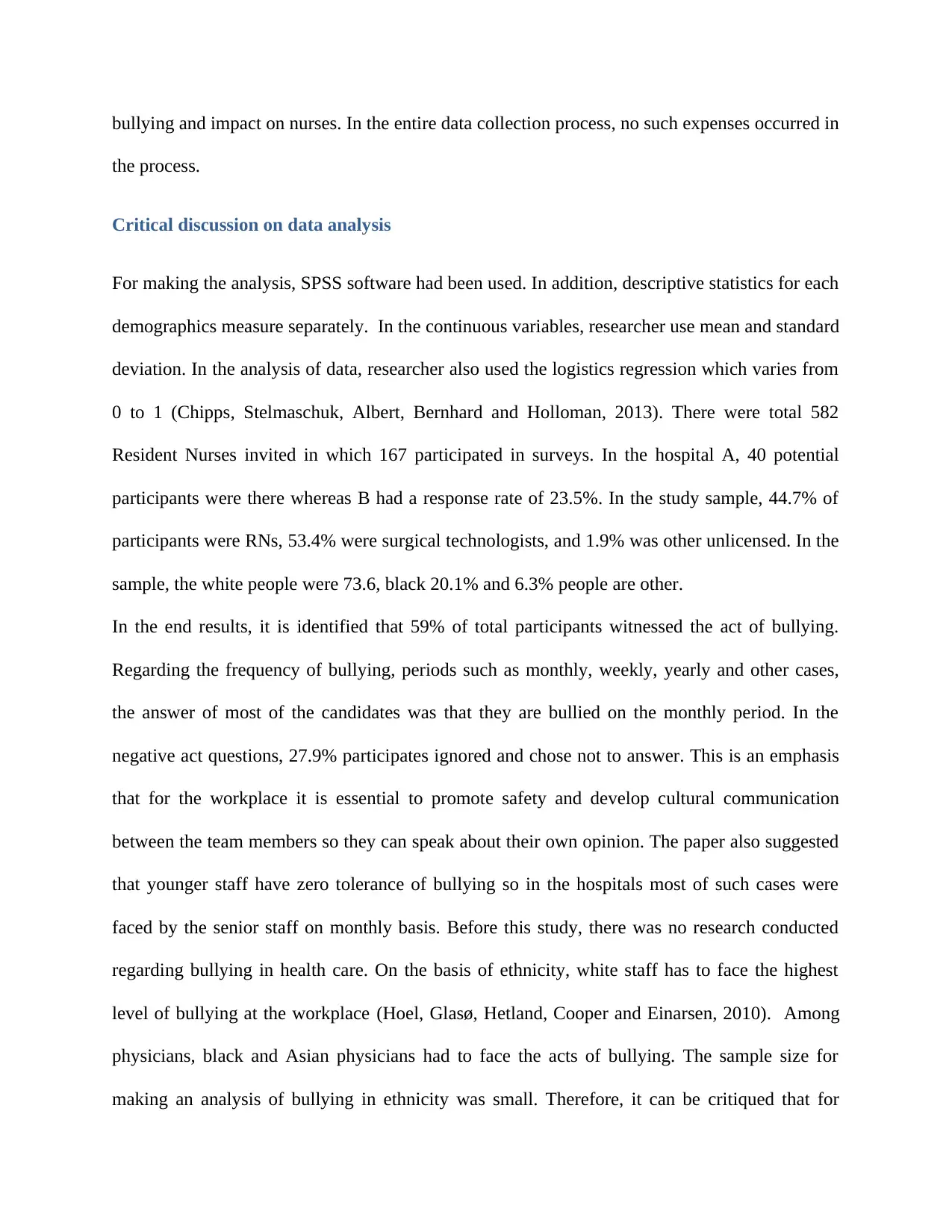
bullying and impact on nurses. In the entire data collection process, no such expenses occurred in
the process.
Critical discussion on data analysis
For making the analysis, SPSS software had been used. In addition, descriptive statistics for each
demographics measure separately. In the continuous variables, researcher use mean and standard
deviation. In the analysis of data, researcher also used the logistics regression which varies from
0 to 1 (Chipps, Stelmaschuk, Albert, Bernhard and Holloman, 2013). There were total 582
Resident Nurses invited in which 167 participated in surveys. In the hospital A, 40 potential
participants were there whereas B had a response rate of 23.5%. In the study sample, 44.7% of
participants were RNs, 53.4% were surgical technologists, and 1.9% was other unlicensed. In the
sample, the white people were 73.6, black 20.1% and 6.3% people are other.
In the end results, it is identified that 59% of total participants witnessed the act of bullying.
Regarding the frequency of bullying, periods such as monthly, weekly, yearly and other cases,
the answer of most of the candidates was that they are bullied on the monthly period. In the
negative act questions, 27.9% participates ignored and chose not to answer. This is an emphasis
that for the workplace it is essential to promote safety and develop cultural communication
between the team members so they can speak about their own opinion. The paper also suggested
that younger staff have zero tolerance of bullying so in the hospitals most of such cases were
faced by the senior staff on monthly basis. Before this study, there was no research conducted
regarding bullying in health care. On the basis of ethnicity, white staff has to face the highest
level of bullying at the workplace (Hoel, Glasø, Hetland, Cooper and Einarsen, 2010). Among
physicians, black and Asian physicians had to face the acts of bullying. The sample size for
making an analysis of bullying in ethnicity was small. Therefore, it can be critiqued that for
the process.
Critical discussion on data analysis
For making the analysis, SPSS software had been used. In addition, descriptive statistics for each
demographics measure separately. In the continuous variables, researcher use mean and standard
deviation. In the analysis of data, researcher also used the logistics regression which varies from
0 to 1 (Chipps, Stelmaschuk, Albert, Bernhard and Holloman, 2013). There were total 582
Resident Nurses invited in which 167 participated in surveys. In the hospital A, 40 potential
participants were there whereas B had a response rate of 23.5%. In the study sample, 44.7% of
participants were RNs, 53.4% were surgical technologists, and 1.9% was other unlicensed. In the
sample, the white people were 73.6, black 20.1% and 6.3% people are other.
In the end results, it is identified that 59% of total participants witnessed the act of bullying.
Regarding the frequency of bullying, periods such as monthly, weekly, yearly and other cases,
the answer of most of the candidates was that they are bullied on the monthly period. In the
negative act questions, 27.9% participates ignored and chose not to answer. This is an emphasis
that for the workplace it is essential to promote safety and develop cultural communication
between the team members so they can speak about their own opinion. The paper also suggested
that younger staff have zero tolerance of bullying so in the hospitals most of such cases were
faced by the senior staff on monthly basis. Before this study, there was no research conducted
regarding bullying in health care. On the basis of ethnicity, white staff has to face the highest
level of bullying at the workplace (Hoel, Glasø, Hetland, Cooper and Einarsen, 2010). Among
physicians, black and Asian physicians had to face the acts of bullying. The sample size for
making an analysis of bullying in ethnicity was small. Therefore, it can be critiqued that for
⊘ This is a preview!⊘
Do you want full access?
Subscribe today to unlock all pages.

Trusted by 1+ million students worldwide
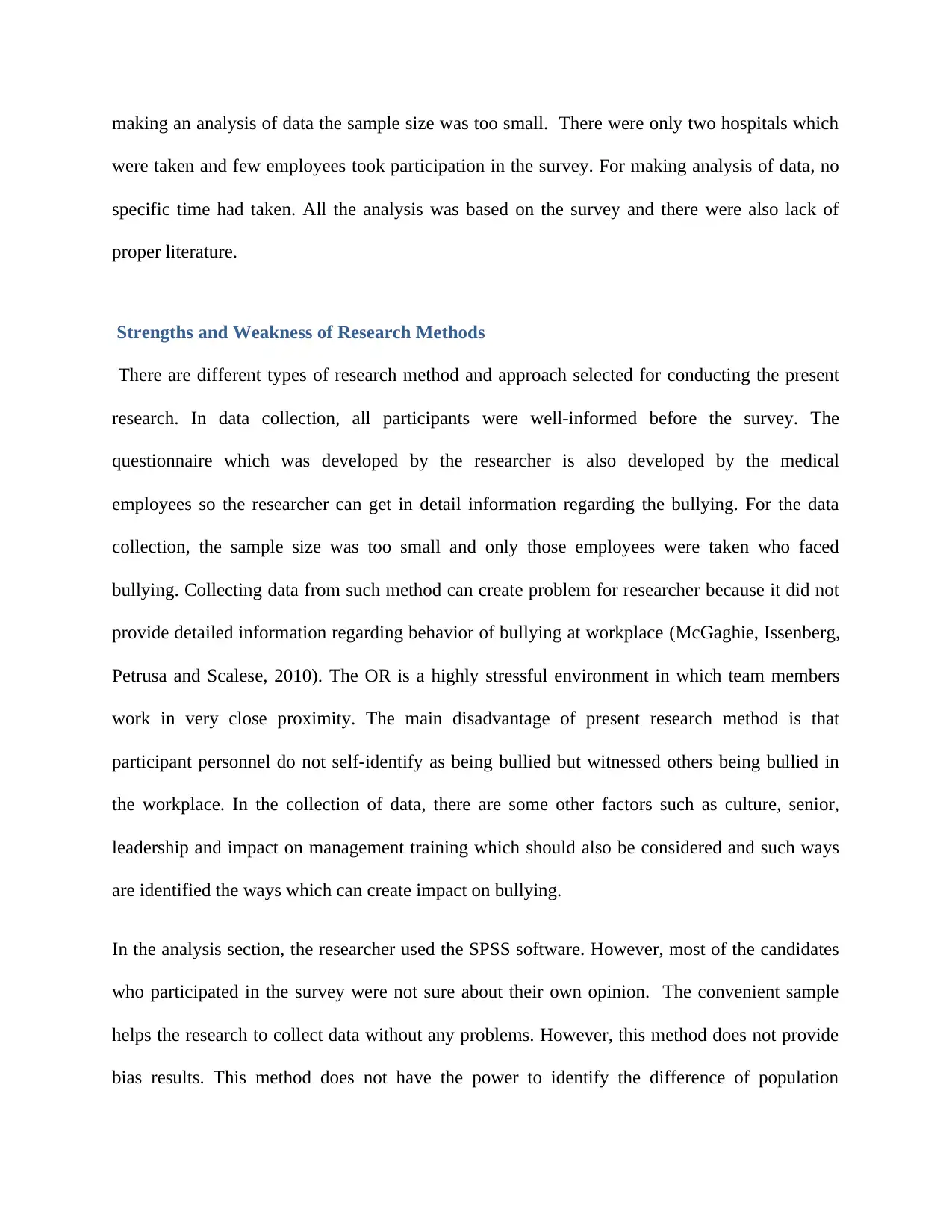
making an analysis of data the sample size was too small. There were only two hospitals which
were taken and few employees took participation in the survey. For making analysis of data, no
specific time had taken. All the analysis was based on the survey and there were also lack of
proper literature.
Strengths and Weakness of Research Methods
There are different types of research method and approach selected for conducting the present
research. In data collection, all participants were well-informed before the survey. The
questionnaire which was developed by the researcher is also developed by the medical
employees so the researcher can get in detail information regarding the bullying. For the data
collection, the sample size was too small and only those employees were taken who faced
bullying. Collecting data from such method can create problem for researcher because it did not
provide detailed information regarding behavior of bullying at workplace (McGaghie, Issenberg,
Petrusa and Scalese, 2010). The OR is a highly stressful environment in which team members
work in very close proximity. The main disadvantage of present research method is that
participant personnel do not self-identify as being bullied but witnessed others being bullied in
the workplace. In the collection of data, there are some other factors such as culture, senior,
leadership and impact on management training which should also be considered and such ways
are identified the ways which can create impact on bullying.
In the analysis section, the researcher used the SPSS software. However, most of the candidates
who participated in the survey were not sure about their own opinion. The convenient sample
helps the research to collect data without any problems. However, this method does not provide
bias results. This method does not have the power to identify the difference of population
were taken and few employees took participation in the survey. For making analysis of data, no
specific time had taken. All the analysis was based on the survey and there were also lack of
proper literature.
Strengths and Weakness of Research Methods
There are different types of research method and approach selected for conducting the present
research. In data collection, all participants were well-informed before the survey. The
questionnaire which was developed by the researcher is also developed by the medical
employees so the researcher can get in detail information regarding the bullying. For the data
collection, the sample size was too small and only those employees were taken who faced
bullying. Collecting data from such method can create problem for researcher because it did not
provide detailed information regarding behavior of bullying at workplace (McGaghie, Issenberg,
Petrusa and Scalese, 2010). The OR is a highly stressful environment in which team members
work in very close proximity. The main disadvantage of present research method is that
participant personnel do not self-identify as being bullied but witnessed others being bullied in
the workplace. In the collection of data, there are some other factors such as culture, senior,
leadership and impact on management training which should also be considered and such ways
are identified the ways which can create impact on bullying.
In the analysis section, the researcher used the SPSS software. However, most of the candidates
who participated in the survey were not sure about their own opinion. The convenient sample
helps the research to collect data without any problems. However, this method does not provide
bias results. This method does not have the power to identify the difference of population
Paraphrase This Document
Need a fresh take? Get an instant paraphrase of this document with our AI Paraphraser
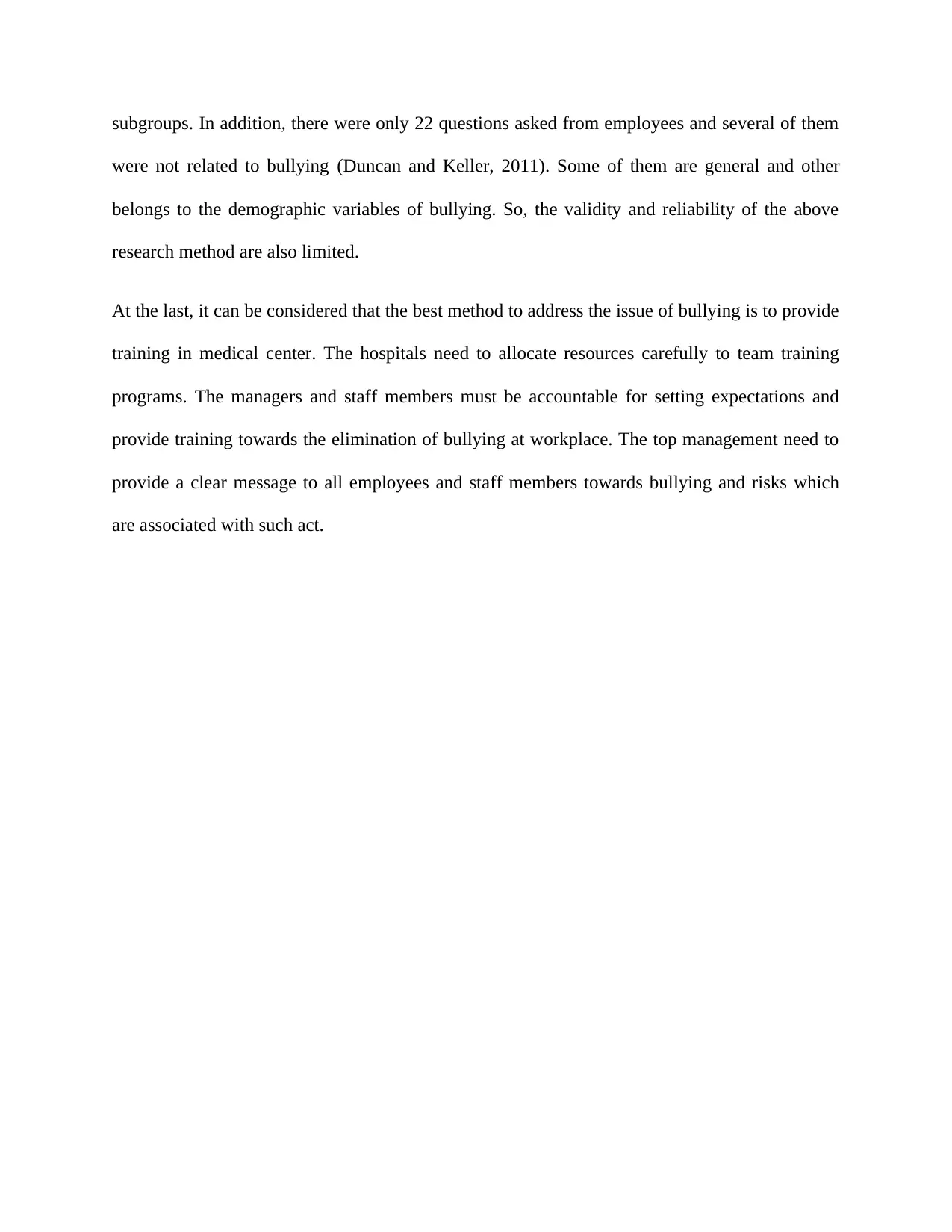
subgroups. In addition, there were only 22 questions asked from employees and several of them
were not related to bullying (Duncan and Keller, 2011). Some of them are general and other
belongs to the demographic variables of bullying. So, the validity and reliability of the above
research method are also limited.
At the last, it can be considered that the best method to address the issue of bullying is to provide
training in medical center. The hospitals need to allocate resources carefully to team training
programs. The managers and staff members must be accountable for setting expectations and
provide training towards the elimination of bullying at workplace. The top management need to
provide a clear message to all employees and staff members towards bullying and risks which
are associated with such act.
were not related to bullying (Duncan and Keller, 2011). Some of them are general and other
belongs to the demographic variables of bullying. So, the validity and reliability of the above
research method are also limited.
At the last, it can be considered that the best method to address the issue of bullying is to provide
training in medical center. The hospitals need to allocate resources carefully to team training
programs. The managers and staff members must be accountable for setting expectations and
provide training towards the elimination of bullying at workplace. The top management need to
provide a clear message to all employees and staff members towards bullying and risks which
are associated with such act.
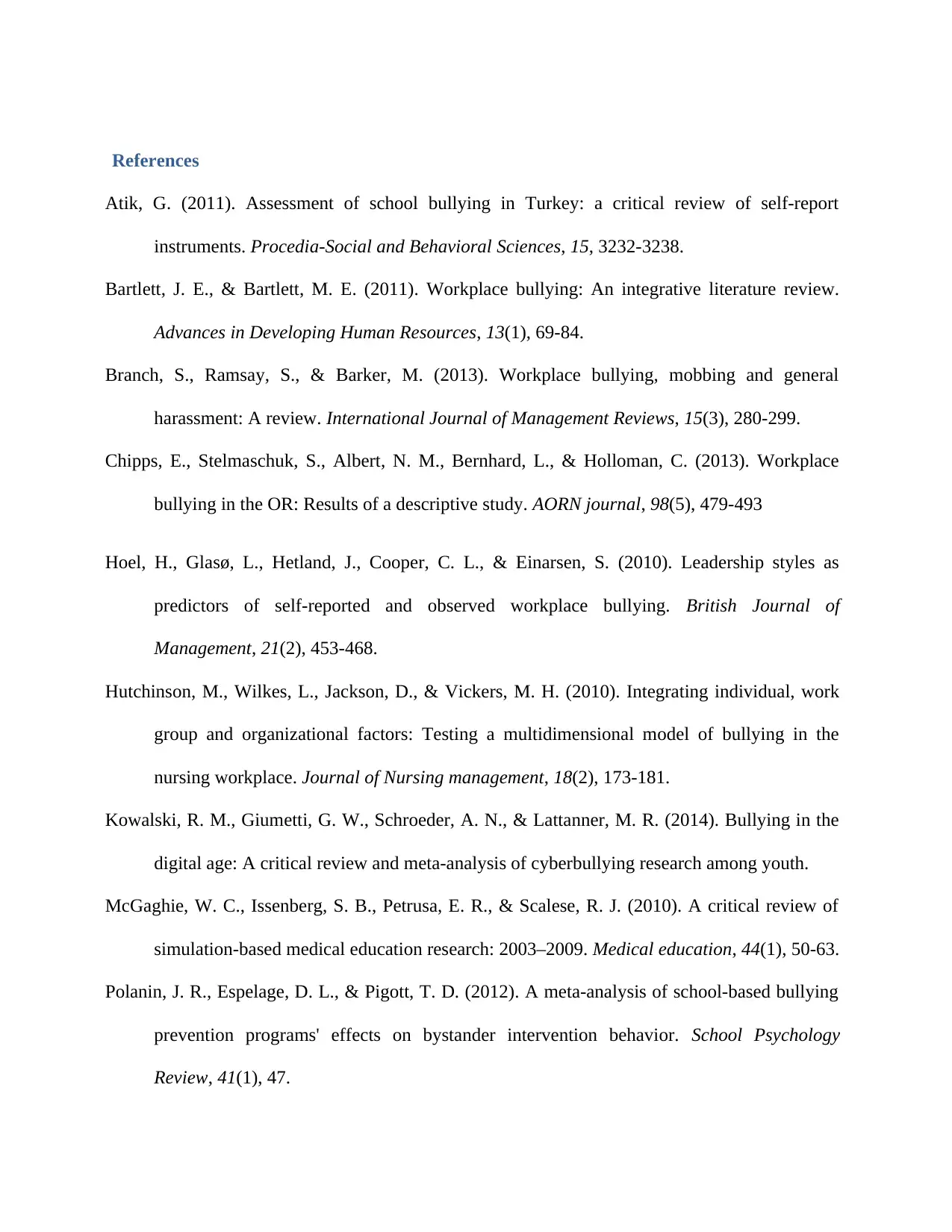
References
Atik, G. (2011). Assessment of school bullying in Turkey: a critical review of self-report
instruments. Procedia-Social and Behavioral Sciences, 15, 3232-3238.
Bartlett, J. E., & Bartlett, M. E. (2011). Workplace bullying: An integrative literature review.
Advances in Developing Human Resources, 13(1), 69-84.
Branch, S., Ramsay, S., & Barker, M. (2013). Workplace bullying, mobbing and general
harassment: A review. International Journal of Management Reviews, 15(3), 280-299.
Chipps, E., Stelmaschuk, S., Albert, N. M., Bernhard, L., & Holloman, C. (2013). Workplace
bullying in the OR: Results of a descriptive study. AORN journal, 98(5), 479-493
Hoel, H., Glasø, L., Hetland, J., Cooper, C. L., & Einarsen, S. (2010). Leadership styles as
predictors of self‐reported and observed workplace bullying. British Journal of
Management, 21(2), 453-468.
Hutchinson, M., Wilkes, L., Jackson, D., & Vickers, M. H. (2010). Integrating individual, work
group and organizational factors: Testing a multidimensional model of bullying in the
nursing workplace. Journal of Nursing management, 18(2), 173-181.
Kowalski, R. M., Giumetti, G. W., Schroeder, A. N., & Lattanner, M. R. (2014). Bullying in the
digital age: A critical review and meta-analysis of cyberbullying research among youth.
McGaghie, W. C., Issenberg, S. B., Petrusa, E. R., & Scalese, R. J. (2010). A critical review of
simulation‐based medical education research: 2003–2009. Medical education, 44(1), 50-63.
Polanin, J. R., Espelage, D. L., & Pigott, T. D. (2012). A meta-analysis of school-based bullying
prevention programs' effects on bystander intervention behavior. School Psychology
Review, 41(1), 47.
Atik, G. (2011). Assessment of school bullying in Turkey: a critical review of self-report
instruments. Procedia-Social and Behavioral Sciences, 15, 3232-3238.
Bartlett, J. E., & Bartlett, M. E. (2011). Workplace bullying: An integrative literature review.
Advances in Developing Human Resources, 13(1), 69-84.
Branch, S., Ramsay, S., & Barker, M. (2013). Workplace bullying, mobbing and general
harassment: A review. International Journal of Management Reviews, 15(3), 280-299.
Chipps, E., Stelmaschuk, S., Albert, N. M., Bernhard, L., & Holloman, C. (2013). Workplace
bullying in the OR: Results of a descriptive study. AORN journal, 98(5), 479-493
Hoel, H., Glasø, L., Hetland, J., Cooper, C. L., & Einarsen, S. (2010). Leadership styles as
predictors of self‐reported and observed workplace bullying. British Journal of
Management, 21(2), 453-468.
Hutchinson, M., Wilkes, L., Jackson, D., & Vickers, M. H. (2010). Integrating individual, work
group and organizational factors: Testing a multidimensional model of bullying in the
nursing workplace. Journal of Nursing management, 18(2), 173-181.
Kowalski, R. M., Giumetti, G. W., Schroeder, A. N., & Lattanner, M. R. (2014). Bullying in the
digital age: A critical review and meta-analysis of cyberbullying research among youth.
McGaghie, W. C., Issenberg, S. B., Petrusa, E. R., & Scalese, R. J. (2010). A critical review of
simulation‐based medical education research: 2003–2009. Medical education, 44(1), 50-63.
Polanin, J. R., Espelage, D. L., & Pigott, T. D. (2012). A meta-analysis of school-based bullying
prevention programs' effects on bystander intervention behavior. School Psychology
Review, 41(1), 47.
⊘ This is a preview!⊘
Do you want full access?
Subscribe today to unlock all pages.

Trusted by 1+ million students worldwide
1 out of 13
Related Documents
Your All-in-One AI-Powered Toolkit for Academic Success.
+13062052269
info@desklib.com
Available 24*7 on WhatsApp / Email
![[object Object]](/_next/static/media/star-bottom.7253800d.svg)
Unlock your academic potential
Copyright © 2020–2025 A2Z Services. All Rights Reserved. Developed and managed by ZUCOL.




